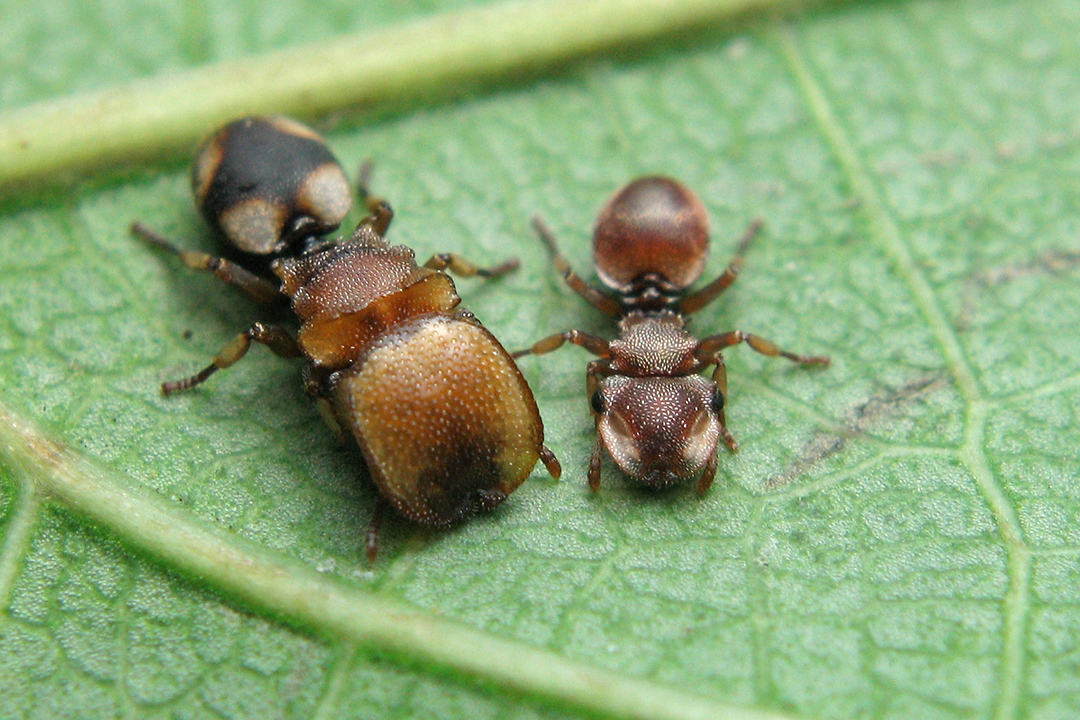Scott Powell has spent a lot of time sitting in trees in eastern Brazil. Among the branches and tropical wildlife, the assistant professor of biology has passed many summer hours watching a remarkable little creature distinguished by a dish-like head that acts as a shield against intruders—the turtle ant. The insect fascinates Powell not only because of the intimate connections between the ant’s unique physical features and its habitat, but also because of its interactions with other ant species
Turtle ants have an elaborate caste system within their society, which includes workers, soldiers, and just one queen for each colony. They get their name from the workers’ peculiar appearance: Much like a turtle, they have an outer shell under which they can pull their antennae and legs when danger lurks nearby. Many can also flatten themselves against the ground or even slide beneath bark to hide from predators.
The soldiers in a turtle ant colony are bigger than workers, and have large shields on their heads, “shaped like a dinner plate,” said Powell. The colonies live in tiny cavities in trees, often vacated by wood-boring beetles. Soldier turtle ants wedge their head plates into the cavity openings from within to protect the colony from marauding groups of foreign ants. A sharp ridge around the edge of the head plate allows the soldier to twist and mechanically screw his head plate into the wood, making it almost impossible for aggressive ants or other predators to invade the colony’s home.
“A colony of turtle ants chooses its home by finding a cavity whose entrance precisely matches its soldier’s head plate,” said Powell, who noted that the genus was mentioned by Charles Darwin in his The Origin of Species. “The head plate is a characteristic that evolved over time and one that helps the turtle ant survive today. It is also indicative of the effect the ants’ environment has had on their physical features over time.”
With data that Powell and his collaborators gathered from observing the ants and measuring their physical attributes and the cavities in which they live a phylogenetic (evolutionary) tree has been created that depicts the relationships among the many turtle ant species—more than 115 of them. The tree diagram is the first of its kind for turtle ants and allows the researchers to explore in greater detail how the environment has shaped the evolution of the group.
Working with Powell on his research are Columbian College post-doctoral scientist Shauna Price and colleagues from the University of Missouri, University of Arizona, and the University of Uberlandia in Brazil. The team has studied turtle ant colonies in their natural environments in Brazil and in the foothills outside of Tucson, Arizona. Powell has also brought an ant colony to his lab at GW and will add more in the future.
To help him better understand how the ants evolved, Powell placed ant colonies in tree cavities that were slightly larger than the soldiers’ head plates. He found that the ants did not survive as well in this environment—often ending up being usurped by other ant species, illustrating that the ants’ bodies evolved based on their habitat.
“Turtle ants have many more species than most other ant genera, and our research sheds light on traits that have allowed diverse groups of organisms to be so successful,” noted Price. “Our research contributes to understanding how diversity was generated in the [Neotropic] region with remarkably high levels of biodiversity.”
Powell’s research team is nearing the end of two, three-year projects funded by the National Science Foundation totaling just over $900,000. He is now putting together a proposal for funding for a larger study on the armor of the turtle ants.
“I want to investigate how the turtle-like shell relates to the ants’ interactions within ant communities and their environment,” explained Powell. “Once we know more about their morphology, we can examine how it influences the contemporary community structure. At any given moment and location, those interactions dictate who can survive in a particular area.”
High-resolution micro-CT scanning and related software offers the researchers a unique glimpse at both the ants’ internal and external structures. With this technology, they can view a three-dimensional image of a slice of an ant’s body, magnifying certain parts and rotating the image to get a better view of defined areas.
“The resolution of the image is remarkable using this technology,” said Powell, who hopes to obtain funding to bring the scanning equipment to GW. “We can use it to visually extract ancient ant fossils from amber to compare them to ants of today.”
Powell and Price are also examining the effects of external factors, such as deforestation and global warming on the ants’ habitat, which can have a cascading effect and impact the ants’ survival. It is of grave concern that much of the Savannah region of Brazil where the ants reside is being turned into farmland.
“I hope to translate our results into conservation-minded perspectives,” Powell said. “Turtle ants have an intimate relationship with the environment in which they live. Over 46 million years, their environment has made them into the complex creatures they are today.”


